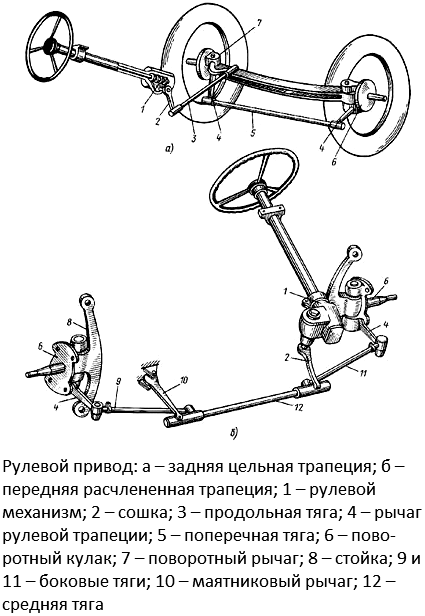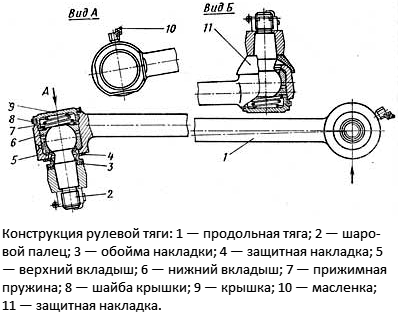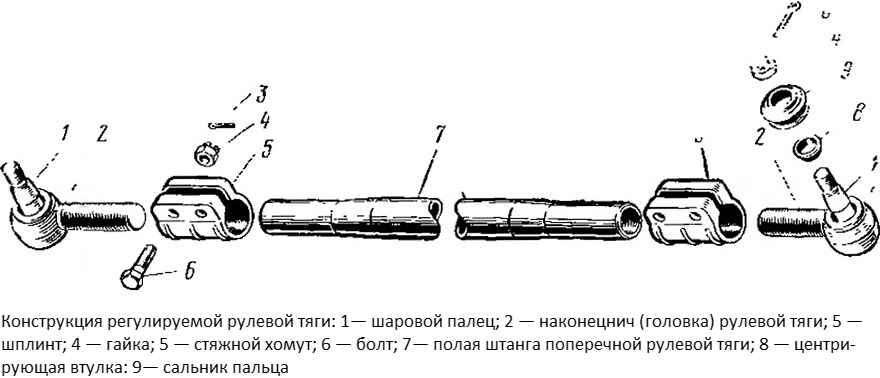
In the steering drive of almost all wheeled vehicles there are elements that transmit the force from the steering mechanism to the wheels - steering rods. All about the steering rods, their existing types, design and applicability, as well as about the correct choice and replacement of these parts - read in the proposed article.
What is steering?
Steering rod - an element of the drive of the steering mechanism of wheeled vehicles (with the exception of tractors and other equipment with a breaking frame); a rod-shaped part with a ball joint (hinges) that provides the transfer of force from the steering mechanism to the levers of the rotary wheel fists and to other components of the steering drive.
The steering of wheeled vehicles is divided into two main parts: the steering mechanism and its drive. The steering mechanism is controlled by the steering wheel, with its help a force is created to deflect the steerable wheels. This force is transmitted to the wheels by means of a drive, which is a system of rods and levers connected by hinges. One of the main parts of the drive are different in location, design and purpose of the steering rods.
Several functions are assigned to the steering rods:
● Transmission of force from the steering mechanism to the associated components of the drive and directly to the levers of the rotary wheel fists;
● Holding the selected angle of rotation of the wheels when performing maneuvers;
● Adjustment of the angle of rotation of the steered wheels depending on the position of the steering wheel and other adjustments of the steering gear in general.
Steering rods solve the responsible task of transferring forces from the steering mechanism to the steered wheels, therefore, in case of malfunction, these parts must be replaced as soon as possible. But for the correct choice of a new rod, it is necessary to understand the existing types, design and features of these parts.
Types and applicability of steering rods

Types and diagrams of trapezoidal steering
Steering rods can be divided into several types by purpose, applicability and some design features.
According to the applicability of thrusts, there are two types:
● For steering systems based on worm and other steering mechanisms and with a steering trapezoidal drive;
● For steering systems based on steering racks with direct wheel drive.
In the systems of the first type (with steering trapezoids), two or three rods are used, depending on the type of suspension of the controlled axle and the steering trapeze scheme:
● On the axle with dependent suspension: two rods - one longitudinal, coming from the steering bipod, and one transverse, connected to the levers of the swivel fists of the wheels;
● On the axle with independent suspension: three rods - one longitudinal middle (central), connected to the bipod of the steering mechanism, and two longitudinal side, connected to the middle and to the levers of the swivel cams of the wheels.
There are also variants of trapezoids on the axle with independent suspension with two side rods connected to the steering bipod at the central point. However, the drive of this scheme is more often used in steering based on steering racks, which are described below.
It should be noted that in the steering trapezoids for the axis with independent suspension, in fact, one steering rod is used, divided into three parts - it is called dissected thrust. The use of dissected steering gear prevents spontaneous deviation of the steered wheels when driving on uneven roads due to different amplitudes of oscillation of the right and left wheels. The trapezoid itself can be located in front of and behind the axle of the wheels, in the first case it is called the front, in the second - the rear (so do not think that the "rear steering trapezoid" is the steering drive located on the rear axle of the car).
In steering systems based on the steering rack, only two rods are used - the right and left transverse for the right and left wheel drive, respectively. In fact, it is a steering trapezoid with a dissected longitudinal thrust, having a hinge at the midpoint - this solution greatly simplifies the design of the steering, increasing its reliability. The rods of this mechanism always have a composite design, their outer parts are usually called steering tips.
Steering rods can be divided into two groups according to the possibility of changing their length:
● Non-adjustable - one-piece rods that have a given length, they are used in drives with other adjustable rods or other parts;
● Adjustable - composite rods, which, due to certain parts, can vary their length within certain limits to adjust the steering gear.
Finally, traction can be divided into many groups according to applicability - for cars and trucks, for vehicles with and without power steering, etc.
Steering rod design
The simplest design has non-adjustable rods - their basis is a hollow or all-metal rod of a particular profile (can be straight or curved in accordance with the design features of the car), at one or both ends of which there are ball joints. Hinges - non-separable, consist of a body with a ball finger located inside with a thread for a crown nut and a transverse hole for a pin; The hinge can be closed with a rubber anther to protect against dirt and water. On the transverse thrust, the finger axes of the ball joints are arranged in the same plane or offset by a small angle. On the longitudinal thrust, the axes of the fingers of the hinges are usually perpendicular to each other.

Somewhat more complex design have non-adjustable transverse rods. In such a thrust, additional elements may be provided:
● In rods for axles with dependent suspension - a hole or hinge for connection with the steering bipod;
● In the rods for axles with independent suspension - two symmetrically arranged holes or hinges for connection with the side rods;
● In rods for cars with hydrostatic steering (GORU) - a bracket or hole for connecting to the rod of the hydraulic cylinder OF THE GORU.
However, on many cars, trapezoids with a pendulum lever are widely used - in such systems, the average lateral thrust on its tips has holes for mounting the pendulum lever and steering bipod.
Adjustable steering rods consist of two main parts: the rod itself and the steering tip connected to it. The tip can change its position relative to the thrust in one way or another, which allows you to adjust the overall length of the part. According to the method of adjusting the thrust, it can be divided into two types:

Adjustable steering rod design with tightening clamps
● Thread adjustment with locking with a lock nut;
● Adjustment by thread or telescopic method with fixation with a tightening clamp.
In the first case, the tip has a thread that is screwed into the response thread at the end of the rod, or vice versa, and the fixation from cranking is carried out by a lock nut on the same thread. In the second case, the tip can also be screwed into the rod, or simply inserted into it, and fixation from cranking is carried out by a tightening clamp on the outer surface of the rod. The tightening clamp can be narrow and tightened with only one bolt with a nut, or wide with a tightening of two bolts.
All steering rods have a hinged connection with each other and with other parts of the steering system - this ensures the normal functioning of the system during deformations that occur during the movement of the vehicle. Ball pins act as the axes of the hinges, they are fixed in the holes of the mating parts with crown nuts fixed with pins.
Rods are made of steel of various grades, they can have a protective coating in the form of ordinary paint or galvanic coating with various metals - zinc, chromium and others.
How to choose and replace the steering rod
Steering rods during the operation of the car are subjected to significant loads, so they quickly become unusable. Most often, problems occur in the ball joints, also the rods are subject to deformation and the appearance of cracks with the subsequent destruction of the part. A malfunction of the rods can be indicated by the backlash and beating of the steering wheel, or, on the contrary, an excessively tight steering wheel, various knocks while driving, as well as a loss of directional stability of the car (it leads away). When these signs appear, the steering should be diagnosed, and if problems with the rods are detected, then they need to be replaced.
For replacement, you should choose those steering rods and tips that were installed on the car earlier - only in this way there are guarantees that the steering will function correctly. If the problem occurred only in one side rod or tip, then it is better to replace these parts in a pair, otherwise there is a very high probability of traction failure on the second wheel.
Replacement of rods must be performed in accordance with the instructions for repair and maintenance of the car. Usually this operation comes down to lifting the car on a jack, dismantling old rods (for which it is better to use a special puller) and installing new ones. After the repair, it is recommended to adjust the camber-convergence. New traction on some cars (especially trucks) should be lubricated periodically, but usually these parts do not require maintenance during the entire service life.
With the right choice and replacement of steering rods, the control of the car will be reliable and confident in all driving modes.
Post time: May-06-2023
